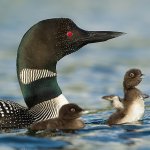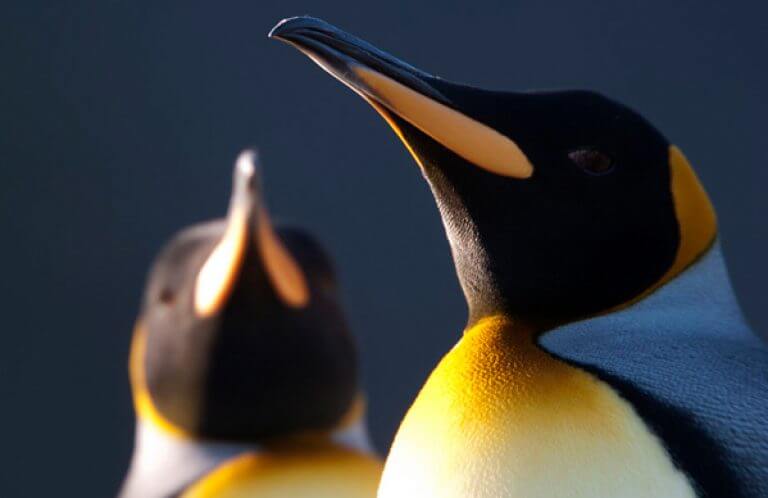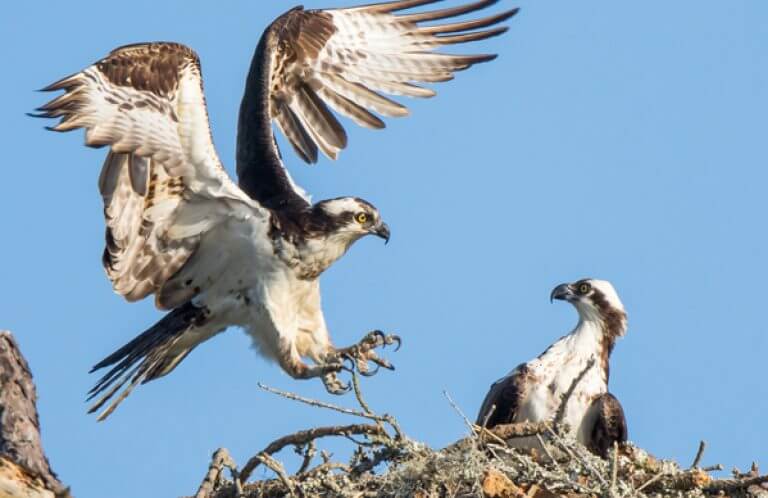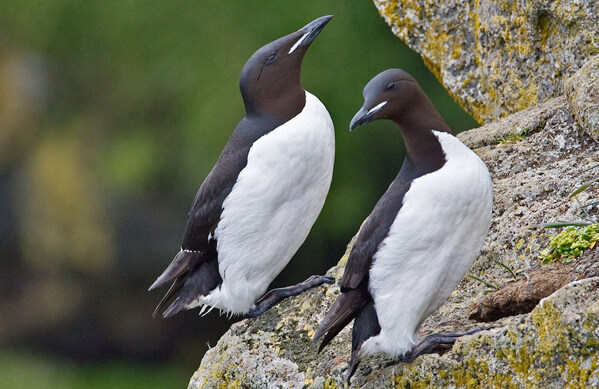About the Common Loon
The Common Loon is the most widespread of the five loon species found in North America. A formidable swimmer and diver like the King Penguin or Red-breasted Merganser, this handsome waterbird is a veritable avian submarine, beautifully adapted to a life in and on the water.
Common Loons have long, low-slung bodies and solid bones, which decrease their buoyancy and allow them to submerge quickly. Their large webbed feet, set far back on their bodies, act as efficient propellers as the birds pursue prey underwater at depths of up to 200 feet. These set-back legs make the bird clumsy on land, where it can barely walk. When forced to go ashore, a Common Loon has to push itself along on its belly. It can only take off from the surface of a large body of water, as it needs a long distance to gain velocity for take-off.
When landing, loons make an inelegant belly flop, then skim along the water on their bellies to slow down. Migrating loons sometimes get into trouble when they mistake icy roads, parking lots, or other solid surfaces for water and can't take off again after landing.
A Common Loon in summer is an eye-catching sight, with bright red eyes, a black-and-white checkered back, iridescent dark-green head, and prominent white necklace. During the winter, it molts into plainer gray and white plumage. Males and females are identical in appearance, although male loons are usually about 25 percent larger.
Songs and Sounds
Common Loons often vocalize at night, adding an other-worldly dimension to their sounds. Ornithologist Arthur Cleveland Bent observed: "The woodland lakes would be solitudes, indeed, did they lack the finishing touch to make the picture complete – the weird and mournful cry of the loon, as he calls to his mate or greets some new arrival. Who has ever paddled a canoe, or cast a fly, or pitched a tent in the north woods and has not stopped to listen to this wail of the wilderness? And what would the wilderness be without it?"
Common Loons have a number of distinctive calls. One of the best-known is a fluttering tremolo call, which some say sounds like crazed laughter, and may have given the bird its common North American name. Common Loons give this call when they feel threatened, particularly in the vicinity of their nests.
(Audio of Common Loon "wail" and "tremolo" calls by Andrew Spencer, XC8189383. Accessible at www.xeno-canto.org/189383)
Another well-known call, the eerie, double-noted wail, seems to function as a contact and gathering call. One vocalization, the yodel, is given only by the male during territorial defense. Each male has his own characteristic yodel, but surprisingly, when a male loon changes territory, he changes his yodel!
A fourth call, the hoot, is a one-note vocalization used by family members to locate each other.
(Audio of Common Loon "wail" call by Richard E. Webster, XC190344. Accessible at www.xeno-canto.org/190344)
Breeding and Feeding
Devoted Pairs and Parents
Like Trumpeter Swans, Common Loons are monogamous, with pair bonds lasting for multiple years. A breeding pair of loons usually defends a territory consisting of an entire small lake or a protected bay within a large lake. Pairs exhibit high site fidelity and will reuse a nest site from the previous year if they successfully hatched chicks there.
Both members of a pair build a large, mounded nest of dead marsh grasses and other plants on the ground or afloat in shallow water, ideally near deep water so they can swim to and from the nest without being seen by predators. Common Loons favor nest sites on small islands but will also build along well-vegetated mainland shorelines.
Male and female Common Loons take turns incubating their eggs and protecting the nest. They raise a single brood of one or two chicks each year. The dark, downy chicks can swim and dive after only two to three days and have the endearing habit of riding on their parents' backs, usually for the first seven to ten days after hatching. Chicks are fed by both parents. As soon as they learn to fly, they leave their birth territories and will find mates of their own at two to three years of age.
The Common Loon is a "pursuit predator," chasing and catching prey underwater, as do the Thick-billed Murre and Tufted Puffin. Since they hunt by sight, loons require clean, clear water to successfully locate prey. They mainly feed on fish, but will also take crayfish, shrimp, and other crustaceans; frogs; insect larvae; mollusks; and aquatic plants. Loons usually swallow their prey underwater, but will bring larger food items to the surface. They stay submerged for up to a minute at a time.
Region and Range
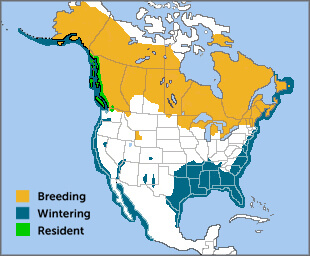
This is a characteristic boreal forest species, breeding in Canada and the northern United States, including Alaska.
Small numbers nest in southern parts of Greenland and Iceland and the arctic regions of Eurasia. Common Loons migrate south to winter on both Atlantic and Pacific coasts as far south as Mexico, and on the Atlantic coast of Europe. They also winter on large lakes, although in lower numbers.
Conservation
Turbines and Other Troubles
Common Loon populations in the continental United States have declined drastically in the face of pollution from coal-burning power plants. Like the Bald Eagle and Osprey, Common Loons are apex predators, so they receive the full dose of toxins such as mercury and acid rain as they accumulate up the food chain.

Help support ABC's conservation mission!
Lead poisoning through ingestion of fishing sinkers, which loons mistake for grit, is another major cause of mortality, and these birds face additional dangers from oil spills, fishing nets, habitat loss, and climate change.
Migrating loons also may be vulnerable to collisions, particularly with wind turbines sited on lakes or other large bodies of water. In December 2019, ABC and partners filed suit in federal court against the U.S. Department of Energy and U.S. Army Corps of Engineers, based on the agencies' failure to comply with the National Environmental Policy Act (NEPA) and Clean Water Act during their evaluation of environmental impacts and alternatives associated with the Icebreaker Wind project. This proposed wind energy facility, which would be located in Lake Erie offshore of Cleveland, could put Common Loons and many other migrating bird species at risk.
Get Involved
Policies enacted by the U.S. Congress and federal agencies, such as the U.S. Fish and Wildlife Service, have a huge impact on migratory birds. You can help shape these rules for the better by telling lawmakers to prioritize birds, bird habitat, and bird-friendly measures. To get started, visit ABC's Action Center.
Living a bird-friendly life can have an immediate impact on migratory birds in the United States. Doing so can be as easy as adding native plants to your garden, avoiding pesticides, and keeping cats indoors. To learn more, visit our Bird-Friendly Life page.
American Bird Conservancy and our Migratory Bird Joint Venture partners have improved conservation management on more than 6.4 million acres of U.S. bird habitat — an area larger than the state of Maryland — over the last ten years. That's not all: With the help of international partners, we've established a network of more than 100 areas of priority bird habitat across the Americas, helping to ensure that birds' needs are met during all stages of their lifecycles. These are monumental undertakings, requiring the support of many, and you can help by making a gift today.






































